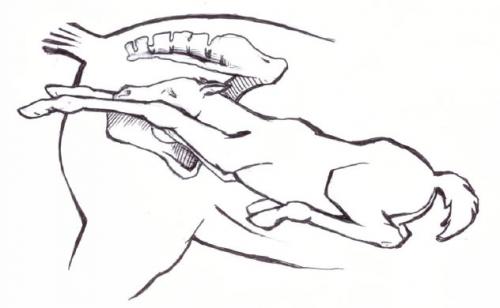Preparing yourself for the birth of your Miniature Horse foal
Dystocia Part 1This is a compilation of several articles and pictures, as well as personal experience, from myself, the team here and breeders the world over who provide us articles to share their own experiences with things that have worked for them in these same situations. First and foremost, and I can't stress this enough, call your veterinarian before proceeding.
Problems with the foaling process are termed dystocia. Dystocia can be catastrophic and costly through loss of the mare or her future fertility and/or loss of the foal. Parturition (foaling) occurs more rapidly in mares than in most other domestic species (minutes vs hours). The sooner dystocia is detected and corrected, the less chance of catastrophic results.
This next section is from a member, named Anna: It's known as the "DON'T WAIT" steps for foaling:
I know that us old (and hopefully experienced) Aunties here on LB keep on and on about the importance of actually being in attendance when a Miniature Horse mare foals in case assistance is needed, and most of you do your very best to be with your girls at this very special time. But some folks like to wait a while and to just watch leaving it to the mare to produce her baby naturally without human interference. In many cases this works just fine, but I have two words that, in my opinion, are more important than anything else at this moment of birth - DONT WAIT!!
Don't wait for your mare to produce her baby by herself - that delay can be too long to correct any difficulties that might be occurring. Once a mare goes down and starts pushing, two or three good contractions (three or four in a maiden mare) should produce the familiar pale 'bubble' of the coming foal. Don’t wait! Get in there with your mare and watch for the first foot to appear as she contracts again making sure they are the front feet (!) Don’t wait. With clean hands and short trimmed nails (no nail polish when foaling mares!) gently feel up inside the vulva for the other foot which should be following close behind. Another contraction and once again feel further in for the 'knob' of the approaching nose, it should be lying approx level with the knees or just beyond them.
If all is well with your foal's position then with the next contraction, you can gently take hold of the legs around the cannon bones, not the fetlocks, and keep a gentle 'pulling' pressure there with every following contraction. Try to keep the first leg still slightly in front of the second exactly as it was presented in the first place, the reason for this is because nature has made it important that one leg leads the other - when the foals elbows come through the birth canal they come at the same time as the withers, together forming a triangle which can put immense pressure on the nerves in the mare's back/spine region, one leg/elbow passing though this tight area of the canal slightly in front of the other reduces this pressure. Make sure that, as you apply your gentle 'pull' on the foals legs, you are keeping the legs coming in the direction of the mare's hocks - downwards, not out towards you.
Once the head clears' the rest of the foal's body should slide out reasonably easily. By now your baby’s legs and head should be curved round towards the mare's tummy - so that if she sits up, she can reach her baby's nose and face to give him/her the first greeting. Quickly clear the bag from the foal's head if it has not already broken and peel it back over the hindquarters. Leave baby laying here while you give it a bit of a rub down with a dry towel as vital blood supply is still passing between mom and child via the cord.
The cord should break naturally as the mare gets to her feet, just pinch the end of it when this happens to stop any bleeding and then dip or swab it with whatever you are using for the purpose. Now is the moment to check for the sex of your new little one, then providing all seems well and the mare is up on her feet, leave the stall and give Momma a chance to see/clean and bond with her new baby - please note that I said HER new baby! As much as you want to cuddle, fuss, fiddle with, coo over this new little life, it does belong to its Momma, NOT to you!! Foals do not see well early on, and go entirely by smell and it is very important that the new baby registers its Momma's scent and not that of human beings. With a straightforward foaling there is no need for any further help at this time, so step back, give yourself a pat on the back, have someone go get a cuppa and just watch the happy pair from a distance.
A healthy baby will often find the teat more quickly if left alone, rather than with human intervention. But you do need to watch out for Momma to pass the afterbirth and baby to pass the first poop. So take a deep breath and as I said, step back and just take pleasure in watching a new little one take its first steps after the miracle of birth!
Luckily most births are without too much difficulty, but DONT WAIT to see how things are going, get right in there with your mare and do those first checks for the early signs of a correctly approaching foal. If one 'thing' seems to be missing DONT WAIT - you may well save the life of your foal and that of your mare by your quick reaction!
Once a mare goes down and starts pushing, and has 3 to 4 minutes of serious contractions with nothing appearing, dont wait, call the vet, better that he comes to find that a foal has arrived than wait any longer if something is wrong!
Only one leg or no nose up past approx knee level, dont wait, call the vet!! (with one leg only, do have a little search for the second one, sometimes it is just hooked over the top of the head and you can pop it back to where it should be!) Try to feel/search without breaking the white bag. And if you do have a wrong presentation, then it is a good idea to get the mare to her feet and walk her slowly round her stall if you can, this can help take the 'force' out of the contractions and help to keep things on hold until the vet can get there, which will make it easier for him to push the foal back in to give room for any adjustments.
Now on to the different foaling presentations -- and how to prepare…..
If you are confronted with any one of these problems, the first thing to remember is do not panic. Call your vet. If you are confident enough you may also try to resolve the situation yourself as many of us do, because of lack of access to a vet. Some of these malpositions -- or dystocias, as they are called -- are common in the world of foal deliveries, and this is presented to help give some basic steps that can be taken to help get baby safely to the ground.
Keep in mind that your vet is going to try to resolve the situation by manually repositioning the foal in order for it to be delivered successfully. Many of us over the years have called the vet for assistance, and then taken the steps below. It is better to have called the vet and have him arrive to find baby safely on the ground, than to wait too long to call him, and compromise baby's "window of opportunity" to survive.
Things to do while waiting for the vet to arrive: The first and most important thing is to get the mare up if she is lying down and get her moving. This will stop contractions and assist the foal to slip back into the uterus making the repositioning task easier. If you have a person to assist you and your mare is quiet, one can lead the mare while the other walks behind the mare with a gloved hand/arm inserted in the birth canal and put pressure on the foal to aid its retreat. If you feel confident to this point you can feel for the foals forelegs and head and reposition them yourself. If not, keep the mare calm and moving and wait for your vet.
Do not put unnecessary pressure on yourself. Take a good look at the pictures and work out in your mind how you would resolve the situation.
Be sure to only do as much as you genuinely feel confident with, that's why we pay vets the big bucks.
Abnormal Presentations of foal (dystocia)
Critical Things to Remember:
Before putting your hand in the mare, ALWAYS WASH carefully and LUBE generously!
If you know there is dystocia, keep mare from pushing and straining, as she is jamming the foal tighter against the pelvic wall. If a mare is walking, she cannot push!
Pointing the mare downhill may help, too
If you pull, only pull with the mare's contractions, and you must pull downwards toward her hocks.
Always think about the arc-like pathway that a foal must follow to emerge from the birth canal. He is delicate, as are the inner tissues of the mare.
Presentations where you MUST PULL THE FOAL OUT NOW!
In the following three presentations, you must always get the foal out immediately. If not, the foal will be oxygen deprived and could die. In all three presentations, the umbilical cord is being pinched so the foal is getting no air from that source. After the umbilicus is cut off, time is of the essence and you have and extremely short “window” before the foal’s first breath and 6 minutes before brain damage.1. Red Bag
You will see red, terry cloth like sac coming out of mare.
The foal is inside of the red sac and white sac. DO NOT WAIT for the vet. You must cut the red sac, go inside that, rip the white sac, go inside that and pull the foal out FAST!
Remember, ALWAYS pull a foal out downwards, towards the hocks of the mare.
In this presentation, the placenta has separated and baby has only minutes to survive as the foal is getting no oxygen.
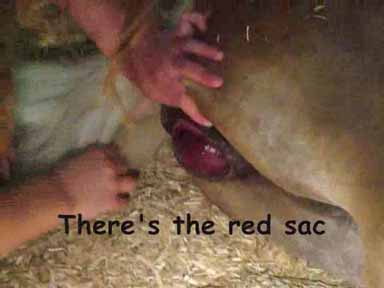
RED BAG BIRTH AND WHAT TO DO - CLICK HERE
http://www.lilbeginnings.com/miniature-horse-facts-and-information/mini-horse-red-bag-birth-what-to-do.shtml
2. Backwards Foal (hind legs coming first)
You know that you have a backwards foal because the hind legs come first. The
soles of the feet are pointing up, and not down as usual. The umbilicus is being
pinched on pelvic rim.
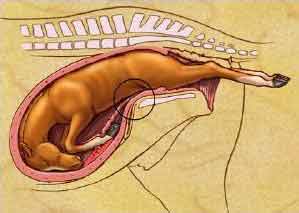
Grasp the legs, and pull toward the mare’s hocks. The tightest fit will be the
foal’s butt/tail, but as you are pulling down, the foal’s front legs should
unravel and baby should make its appearance.
With this presentation, you will have to make sure that baby’s nose is cleared
of fluid, as the foal’s head has been laying in the pool of amniotic fluid, so
once on the ground, pay attention to clearing the foal’s airways.
3. Hip lock (Foal's pelvis is locked on the mare’s
pelvis. Four approaches for unlocking....
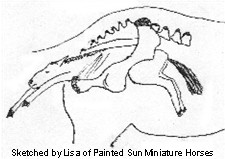
First approach – cross foal’s front legs, and while
pushing foal back into mare (only push during a time of no contractions) twist
the front legs in a rotational movement. If the foal doesn’t “pop” out, cross
legs the other way and try again
Second approach – Roll mare onto back. Have helpers
hold her on back. Grasp the foal’s forelegs. Even though you are still pulling
towards the mare’s hocks, you are now pulling towards your waist because the
mare is on her back. Baby should pop out
Third approach – grasp foal’s front legs and pull
down to the left, then down to the right, slowly trying to walk foal through
birth canal. Alternate the way you are pulling, down to left, down to right.
Fourth approach - Grasp foal's forelegs and attempt
to rotate foal 180 degrees, pull foal upwards and out.
Foaling Presentations that may need your intervention....and a nearby vet.
1. One forefoot or foreleg deflected back (most common
dystocia)
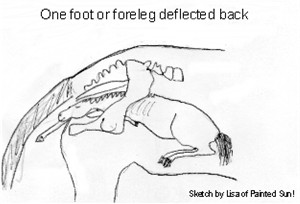
You will see only one leg and a nose.
Tie a clean shoe string around the visible pastern. Next, push the head and leg back into uterus a little ways. Slide your clean, well lubricated hand into mare, with palm towards center. Locate hooked leg, slip two fingers behind knee, pull up, then towards the middle of foal’s chest, then out. If the leg does not come, try grasping toe of hoof and bringing it forward.
(If the foal’s left leg is missing, use your left hand with the palm towards center of mare) Whenever you are moving foal’s legs inside the mare, protect her uterus from the sharp hooves by cupping the foal’s hoof in your hand.
2. Both forelegs back (second most common dystocia)
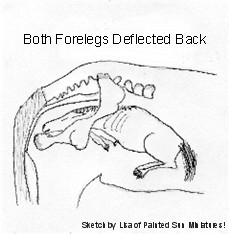
You will see the nose, but there will be no legs
If the foal has a blue tongue, don’t worry; that is normal in this situation
Enter with your palm towards center and do the same process as written above on both legs instead of just one leg
3. Head caught on pelvic rim
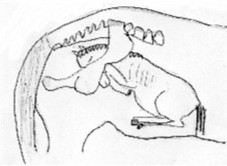
The legs may or may not be in birth canal.
Tie string to visible pasterns and then reach in mare. Find the foal’s two mandibles, then run your hand down his face to his chin. Grasp under chin while having your helper push the foal back into uterus. (with each contraction, the foal’s head is being jammed harder and harder into the pelvic rim. That is why the helper must push foal back to undo the blockage) with your hand under the chin, gently but firmly pull on it and unhook from the rim. Once the head straightens, the foal will deliver without further ado.
4. Head & neck turned to one side
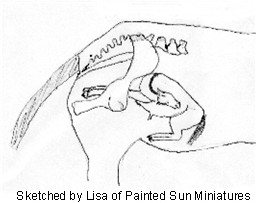
This presentation may look like the one above, but when you put your hand in, on one side of the foal will be a mass of neck. Tie strings to the pasterns, and, while helper is pushing foal back, slide hand along neck to chin. Grasp chin and gently straighten head.
5. Upside Down
You will see the soles pointing upwards, telling you that the foal is either upside down or backwards. Discern position by entering and trying to find head or hocks. If there is a head, the foal is upside down.
This position may correct itself. Allow time for the mare’s rotational contractions to turn foal. Allow time for mare to lay down and roll to position foal before getting worried.
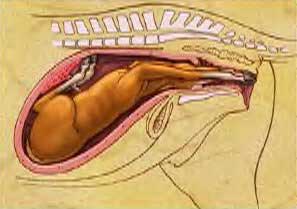
The upside-down foal is a situation where the foal is starting to be born in a forward position but is trying to come out on it’s back with its feet pointing toward the mare’s backbone. The natural arc of the mare’s pelvic cavity and bend of the foal’s torso will not allow this birth to occur. The only option is for the foal to be rotated 180 degrees to the normal foaling position where it is lying on it’s stomach as it comes through the birth canal. First of all it needs to be determined whether this is a posterior delivery or an upside down delivery. In both cases, the pads of the feet will be pointing upward. In this case, a person will encounter the front “knees” and head with the lower jaw upside down behind the upturned hooves. This is a difficult dystocia to resolve. In order to accomplish it, it is necessary to guide one front leg above the head while passing the other beneath the head. Of course all of this has to be done in the mare’s uterus. Placing a strap on one leg and having someone hold and put pressure in the desired direction of one leg helps while a hand is used to guide the other leg around the head in the opposite direction. If successful in rotating the foal, the delivery of the foal will be in the normal position.
Work with the pre-established direction of the foal. If foal is tipped to your left, grasp foal’s legs and cross right leg over left. Hold the legs crossed, and wait for mare’s contractions to pull. (mare should by laying down). When she pushes, pull and twist firmly but gently. Rolling the foal happens gradually, not suddenly. Don’t pull when the mare is not having a contraction, but in between contractions, don’t let the foal slip back, hold all progress you have made.
Click here for a story from an experienced breeder about upside down foals. (link will open in a new window)
Continued.......
PLEASE CLICK HERE FOR PART TWO
